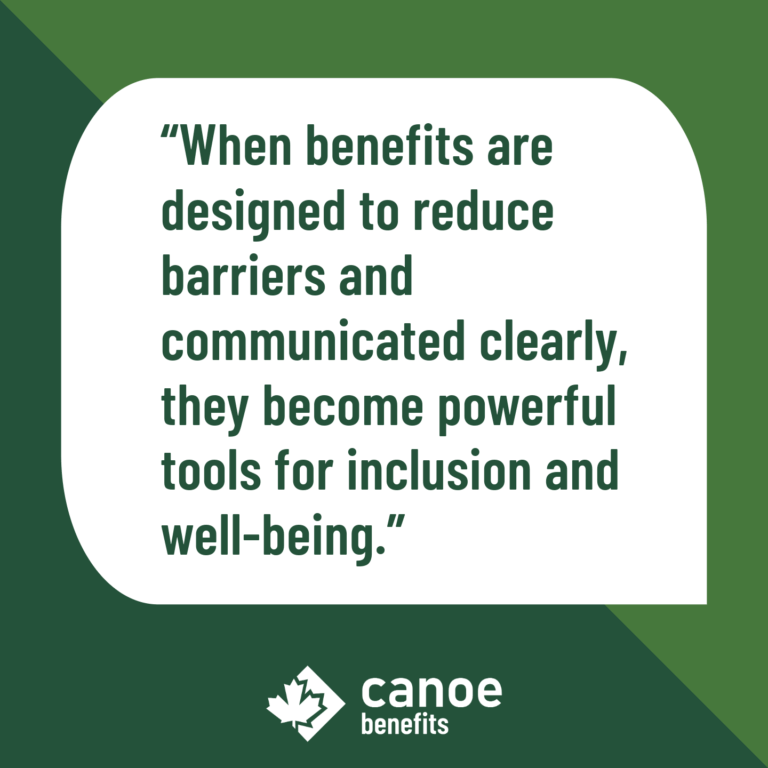By Canoe Benefits
October is ADHD Awareness Month, and it’s a timely opportunity to reflect on what it means to create more inclusive workplaces, especially for neurodivergent employees. Whether someone lives with ADHD, is on the autism spectrum, or has a learning disability, their experience at work can be shaped by how well they’re supported and understood.
For neurodivergent employees, group benefits can play a meaningful role in making the workplace more accessible. From therapy coverage to everyday accommodations, benefits help reduce some of the friction that these individuals may face.
A Growing Call for Neuroinclusion at Work
Over the past few years, more organizations have begun to understand that neurodiversity isn’t just a buzzword; it’s a reality for many employees. Up to 20% of the population is considered neurodivergent, and that number may be even higher due to underdiagnosis, particularly among women and people of colour.
Yet traditional workplace structures often weren’t built with neurodivergent individuals in mind. Tasks like managing email overload, juggling tight deadlines, or sitting through back-to-back meetings can feel especially overwhelming.
This is where thoughtful support through group benefits can make a difference. When benefits are communicated clearly and designed to reduce barriers, they become powerful tools for inclusion and well-being.

Benefits That Help Meet Diverse Needs
Employee benefits can offer several types of support that align with the needs of neurodivergent employees. These might include:
- Access to mental health professionals with experience in ADHD, autism, or learning differences
- Flexible counselling options through Employee Assistance Programs (EAPs)
- Coverage for assessments that can lead to an accurate diagnosis
- Virtual care for more accessible support without the stress of commuting
EAPs, in particular, are often underutilized but incredibly valuable. They offer confidential, short-term support that can help neurodivergent employees navigate workplace challenges, stress, or personal concerns. When promoted consistently, EAPs can provide a soft entry point into broader mental health care.
Creating a More Supportive Environment
Meaningful inclusion doesn’t stop with what’s covered under the benefits plan. The culture of a workplace plays just as important a role. Many neurodivergent employees thrive when they have some flexibility around how they work, communicate, and manage their day.
Even small adjustments can make a real difference. This might include written follow-ups after meetings, the option for flexible scheduling, or creating quieter areas within the office. These kinds of shifts can help reduce overwhelm and create a more accessible space for focus and productivity.
One of the most effective ways to make these accommodations feel normal is to talk about them openly. Inclusive language in internal resources, open conversations around different working styles, and leadership that encourages flexibility all go a long way. Employees should feel like they can ask about adjustments without needing to explain or justify their needs.
If you’re wondering how these kinds of practices can align with your current group benefits strategy, your Canoe advisor is always here to help you think it through.
A Moment to Reflect: World Mental Health Day
World Mental Health Day falls on October 10 and is another opportunity to check in on how your workplace is supporting employee well-being.
Mental health and neurodiversity are deeply connected. Many neurodivergent individuals also experience anxiety, depression, or burnout, particularly in environments that lack understanding or flexibility.
Here are a few ways to make mental health a visible part of your workplace culture:
- Remind employees about mental health coverage or EAP access
- Offer training or discussion opportunities around mental health and inclusion
- Check in with managers to make sure they feel equipped to support diverse teams
Rethinking How Benefits Are Shared
Having a solid benefits plan is a great start, but it won’t go far if the experience around it feels confusing or hard to navigate. For neurodivergent employees, unclear instructions or overly formal processes can become an unexpected barrier.
This is where communication plays a bigger role than we often realize. Benefits don’t need to be complicated to sound professional. In fact, the more approachable the language, the more likely it is that people will engage with what’s available.
Instead of burying information in long PDFs or hard-to-find intranet pages, think about how your team actually interacts with workplace resources. Are they getting answers when they need them? Is the language clear and inviting, not just technically correct? Is there someone they trust to go to for help?
A small shift in tone or format can turn an overwhelming task into a more accessible one. Whether it’s reworking benefit summaries or making sure there’s a friendly face available for questions, these touchpoints shape how employees experience support in their everyday lives.
If your materials could use a refresh, your Canoe advisor can help you rework what’s already there and make it feel more approachable for everyone.
